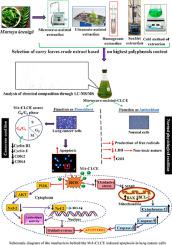Phytomedicine ( IF 7.9 ) Pub Date : 2022-06-13 , DOI: 10.1016/j.phymed.2022.154272 Priya Mondal 1 , Jagadish Natesh 1 , Dhanamjai Penta 1 , Syed Musthapa Meeran 1

|
Background
Lung cancer is the leading cause of cancer-related death worldwide. Dietary bioactives have been used as alternative therapeutics to overcome various adverse effects caused by chemotherapeutics. Curry leaves are a widely used culinary spice and different parts of this plant have been used in traditional medicines. Curry leaves are a rich source of multiple bioactives, especially polyphenols and alkaloids. Therefore, extraction processes play a key role in obtaining the optimum yield of bioactives and their efficacy.
Purpose
We aim to select an extraction process that achieves the optimum yield of bioactives in curry leaves crude extract (CLCE) with minimum solvent usage and in a shorter time. Further, to investigate the anticancer properties of CLCE and its mechanism against lung cancer.
Methods
Different extraction processes were performed and analyzed polyphenol content. The bioactives and essential oils present in curry leaves were identified through LC-MS/MS and GC-MS analysis. The cytotoxicity of microwave-assisted CLCE (MA-CLCE) was investigated through MTT and colony-forming assays. The DNA damage was observed by comet assay. The apoptotic mechanisms of MA-CLCE were investigated by estimating ROS production, depolarization of mitochondrial membrane potential (MMP), and apoptotic proteins. The glutathione assay estimated the antioxidant potential of MA-CLCE in normal cells.
Results
Generally, conventional extraction methods require high temperatures, extra energy input, and time. Recently, green extraction processes are getting wider attention as alternative extraction methods. This study compared different extraction processes and found that the microwave-assisted extraction (MAE) method yields the highest polyphenols from curry leaves among other extraction processes with minimum processing. The MA-CLCE functions as an antioxidant under normal physiological conditions but pro-oxidant to cancer cells. MA-CLCE scavenges free radicals and enhances the intracellular GSH level in alveolar macrophages in situ. We found that MA-CLCE selectively inhibits cell proliferation and induces apoptosis in cancer cells by altering cellular redox status. MA-CLCE induces chromatin condensation and genotoxicity through ROS-induced depolarization of MMP. The depolarization of MMP causes the release of cytochrome c into the cytosol and activates the apoptotic pathway in lung cancer cells. However, pretreatment with ascorbic acid, an antioxidant, inhibits the MA-CLCE-induced apoptosis by reducing ROS production, which impedes mitochondrial membrane disruption, preventing BAX/BCL-2 expression alteration. Simultaneously, MA-CLCE downregulates the expression of survival signaling regulator PI3K/AKT, which modulates Nrf-2. MA-CLCE also diminishes intracellular antioxidant proficiency by suppressing Nrf‐2 expression, followed by HO-1 expressions.
Conclusion
Among several extraction methods, MA-CLCE is rich in several bioactives, especially polyphenols, alkaloids, and essential oils. Here, we reported for the first time that MA-CLCE functions as a pro-oxidant to lung cancer cells and acts as an antioxidant to normal cells by regulating different cellular programs and signaling pathways. Therefore, it can be further developed as a promising phytomedicine against lung cancer.
中文翻译:

Murraya koenigii 提取物通过靶向人非小细胞肺癌中的 PI3K/AKT/Nrf2/caspase-3 信号通路改变氧化还原状态选择性地导致基因组不稳定性
背景
肺癌是全球癌症相关死亡的主要原因。膳食生物活性物质已被用作替代疗法,以克服化学疗法引起的各种不良反应。咖喱叶是一种广泛使用的烹饪香料,这种植物的不同部分已被用于传统药物。咖喱叶富含多种生物活性物质,尤其是多酚和生物碱。因此,提取过程在获得生物活性物质的最佳产量及其功效方面起着关键作用。
目的
我们的目标是选择一种提取工艺,以最少的溶剂用量和更短的时间实现咖喱叶粗提物 (CLCE) 中生物活性物质的最佳产量。进一步研究CLCE的抗癌特性及其抗肺癌机制。
方法
进行了不同的提取过程并分析了多酚含量。通过 LC-MS/MS 和 GC-MS 分析鉴定了咖喱叶中存在的生物活性物质和精油。通过 MTT 和集落形成试验研究了微波辅助 CLCE (MA-CLCE) 的细胞毒性。通过彗星试验观察DNA损伤。通过估计 ROS 的产生、线粒体膜电位 (MMP) 的去极化和凋亡蛋白来研究 MA-CLCE 的凋亡机制。谷胱甘肽测定估计了 MA-CLCE 在正常细胞中的抗氧化潜力。
结果
通常,传统的提取方法需要高温、额外的能量输入和时间。最近,绿色提取工艺作为替代提取方法受到越来越广泛的关注。本研究比较了不同的提取工艺,发现微波辅助提取 (MAE) 方法从咖喱叶中提取的多酚是其他提取工艺中处理量最少的方法中最高的。MA-CLCE 在正常生理条件下起到抗氧化剂的作用,但对癌细胞起到促氧化剂的作用。MA-CLCE 清除自由基并原位增强肺泡巨噬细胞的细胞内 GSH 水平。我们发现 MA-CLCE 通过改变细胞氧化还原状态选择性地抑制细胞增殖并诱导癌细胞凋亡。MA-CLCE 通过 ROS 诱导的 MMP 去极化诱导染色质凝聚和遗传毒性。MMP 的去极化导致细胞色素 c 释放到细胞质中并激活肺癌细胞中的凋亡途径。然而,用抗坏血酸(一种抗氧化剂)预处理通过减少 ROS 的产生来抑制 MA-CLCE 诱导的细胞凋亡,从而阻止线粒体膜破坏,防止 BAX/BCL-2 表达改变。同时,MA-CLCE 下调了调节 Nrf-2 的生存信号调节因子 PI3K/AKT 的表达。MA-CLCE 还通过抑制 Nrf-2 表达,然后是 HO-1 表达来降低细胞内抗氧化能力。
结论
在几种提取方法中,MA-CLCE 富含多种生物活性物质,尤其是多酚、生物碱和精油。在这里,我们首次报道了 MA-CLCE 作为肺癌细胞的促氧化剂,并通过调节不同的细胞程序和信号通路作为正常细胞的抗氧化剂。因此,它可以进一步发展为一种有前途的抗肺癌植物药物。


























 京公网安备 11010802027423号
京公网安备 11010802027423号